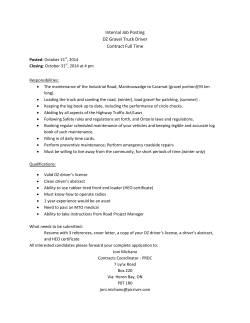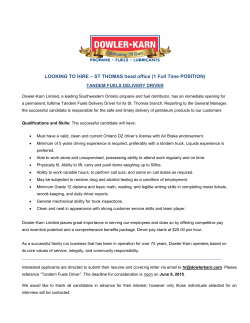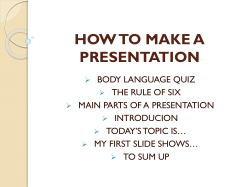
(2015), Volume 3, Issue (3): 13- 1
ISSN 2348 – 0319 International Journal of Innovative and Applied Research (2015), Volume 3, Issue (3): 13- 18 Journal home page: http://www.journalijiar.com INTERNATIONAL JOURNAL OF INNOVATIVE AND APPLIED RESEARCH RESEARCH ARTICLE Drowsy Driver Warning System Using Image Processing Sharad Nagargoje and Prof. D. S. Shilvant Shreeyash College of Engineering and Technology, Department of Electronics and Telecommunication, Dr. Babasaheb Ambedkar Marathwada University Aurangabad Maharashtra, India. ……………………………………………………………………………………………………… Abstract: Driver in-alertness is an important cause for most accident related to the vehicles crashes. Driver fatigue resulting from sleep deprivation or sleep disorders is an important factor in the increasing number of the accidents on todays roads. Drowsy driver warning system can form the basis of the system to possibly reduce the accidents related to drivers drowsiness. The purpose of such a system is to perform detection of driver fatigue. By placing the camera inside the car, we can monitor the face of the driver and look for the eye-movements which indicate that the driver is no longer in condition to driver is no longer in condition to drive. In such a case, a warning signal should be issued. This paper describes how to find and track the eyes. We also describe a method that can determine if the eyes are open or closed. The main criterion of this system is that it must be highly non-intrusive and it should start when the ignition is turned on without having at the driver initiate the system. Nor should the driver be responsible for providing any feedback to the system. The system must also operate regardless of the texture and the color of the face. It must also be able to handle diverse condition such as changes in light, shadows, reflections etc. In given paper a drowsy driver warning system using image processing as well as accelerometer is proposed. Key Words: ……………………………………………………………………………………………………… I. Introduction The innovations in the automobile industry over the last hundred years have made our vehicles more powerful, easier to drive and control safer more energy efficient, and more environmentally friendly. Majority of the accidents caused today by cars are mainly due to the driver fatigue. Driving for a long period of time causes excessive fatigue and tiredness which in turn makes the driver sleepy or loose awareness. With the rapid increase in the number of accidents seems to be increasing day to day. Therefore a need arises to design a system that keeps the driver focused on the road. Data on road accidents in India are collected by Transport Research Wing of Ministry of Road Transport and Highways. The aim of this paper is to develop a prototype of drowsy driver warning system. Our whole focus and concentration will be placed on designing the system that will accurately monitor the open and closed state of the drivers eye in real time. By constantly monitoring the eyes, it can be seen that the symptoms of driver fatigue can be detected early enough to avoid an accident. This detection can be done using a sequence of images of eyes as well as face and head movement. The observation of eye movements and its edges for the detection will be used. Devices to detect when drivers are falling asleep and to provide warnings to alert them of the risk, or even control the vehicles movement, have been the subject to much research and development. Driver fatigue is a serious problem resulting in many thousands of road accidents each year. It is not currently possible to calculate the exact number of sleep related accidents because of the difficulties in detecting whether fatigue was a factor and in assessing the level of fatigue. However research suggests that up to 25 Young male drivers, truck drivers, company car drivers and shift workers are the most at risk of falling asleep while driving. However any driver travelling long distances or when they are tired, it is at the risk of a sleep related accidents. The early hours of the morning and the middle of the afternoon are the peak times for fatigue accidents and long journeys on monotonous roads, particularly motor-ways, are the most likely to result in a driver falling asleep. In this paper the algorithms for face detection and eye tracking have been developed on frontal faces with no restrictions on the background .The proposed method for eye tracking is built into five stages. Using frontal images obtained from a database, the probability maps for the eyes region are built etc. 13 ISSN 2348 – 0319 International Journal of Innovative and Applied Research (2015), Volume 3, Issue (3): 13- 18 II. TECHNIQUES FOR DETECTING DROWSINESS STATE Techniques can be divided into following categories 1. Sensing of physiological characteristics 2. Sensing of driver operation 3. Sensing of vehicle response 4. Monitoring the response of driver The technique of sensing of vehicle operation is well suited for real world driving conditions since it can be nonintrusive by using optical sensors of video cameras to detect changes. Above mentioned first technique is not realistic since the sensing electrodes would have to be attached directly to the driver which will distract the driver. Even long time driving in summer may lead to perspiration on sensors, diminishing their ability to monitor accurately. Driver operation and vehicle behavior can be implemented by monitoring the steering wheel movement, accelerator or brake patterns, vehicles speed, lateral acceleration and lateral displacement which is also non-intrusive ways. The last one is by monitoring the response of driver which included periodically requesting the driver to send a response to the system. Among the techniques mentioned above, the best one is sensing of physiological characteristics phenomena. This technique will be implemented in two ways. 1. Measuring changes in physiological signals, such as brain waves, heart rates and eye blinking. 2. Measuring physical changes such as sagging posture, leaning of the drivers head and open or closed state of the drivers. III. METHOD The proposed method is built in four stages and it is applied to the colored images with any background. 1. Localization of Face 2. Localization of the Eyes 3. Tracking the eyes in the subsequent frames. 4. Detection of failure in tracking. Localization of Face: Since the Face is symmetric, we use a symmetry-based approach. We found that it is enough to use a sub sampled, gray-scale version of the image. A symmetry-value is then computed for every pixel-column in the reduced image. If the image is represented as I(x, y) then the symmetry value for a pixel-column is given by S(x) = [abs I ((x,y-w)-(x,y+w))]. S(x) is computed for X [k,size-k] where k is the maximum distance from the pixel-column that symmetry is measured, and x size is the width of the image. The x corresponding to the lowest value of S(x) is the center of the face. Fig. 1. The Symmetry Histogram 14 ISSN 2348 – 0319 International Journal of Innovative and Applied Research (2015), Volume 3, Issue (3): 13- 18 Fig. 2. The original image, the edges and the histogram of projected edges Location of Eyes: A raster scan algorithm is used for the exact location of the eyes and extracts that vertical location of eyes. Fig. 3. Detection of eye Tracking of the eyes: We track the eye by looking for the darkest pixel in the predicted region. In order to recover from tracking errors, we make sure that none of the geometrical constraints are violated. If they are, we relocalize the eyes in the next frame. To find the best match for the eye template, we initially center it at the darkest pixel, and then perform a gradient descent in order to find a local minimum. Detection of Drowsiness: As the driver becomes more fatigued, we expect the eye-blinks to last longer. We count the number of consecutive frames that the eyes are closed in order to decide the condition of the driver. For this, we need a robust way to determine if the eyes are open or closed; so we used a method that looks at the horizontal histogram across the pupil. IV. EXPERIMENTAL SET-UP Fig. 4. Block Diagram The final system consists of a camera pointing at the driver. The camera is to be mounted on the dashboard inside the vehicle. For the system we are developing, the camera is stationary and will not adjust its position or zoom during operation. For experimentation, we are using a webcam. The grabbed frames are represented in RGB-space with 8-bit pixels (256 colors). We will not be using any specialized hardware for image processing. Given below is the block diagram. V. FLOWCHART OF THE PROJECT The function of the system can be broadly divided into eye detection function, comprising the first half of the preprocessing routine, and a drowsiness detection function, comprising the second half. After inputting a facial image, preprocessing is performed to binarize the image and remove noise, which makes it possible for the image to be accepted by the image processor. The maximum width of the face is then detected so that the right and left edges of the face can be identified. After that the vertical position of each eye is detected independently within an area defined by the center line of the face width and lines running through the outermost points of the face. On that basis, the area in which each eye is present is determined. Once the areas of eye presence have been defined, they can be updated by tracking the movement of the eyes. The degree of eye 15 ISSN 2348 – 0319 International Journal of Innovative and Applied Research (2015), Volume 3, Issue (3): 13- 18 openness is output simultaneously with the establishment or updating of the areas of eye presence. That value is used in judging whether the eyes are open or closed and also in judging whether the eyes have been detected correctly or not. If the system judges that the eyes have not been detected correctly, the routine returns to the detection of the entire face. The following explains the eye detection procedure in the order of the processing operations. Fig. 5. System Configuration a) Preprocessing The preprocessing operations include the binarization of a facial image to increase the processing speed and conserve memory capacity and noise removal. The image processor developed for this drowsiness warning system performs the expansion and contraction operation on the white pixels and processing for noise removal is performed on the small black pixels of the facial images. After the binarization, the noise removal procedure involves an expansion processing method combined with the use of a median filter. These preprocessing operations are sufficient to support detection of the vertical positions of the eyes. However, following identification of the eye positions, the size of the eyes must be converted back to the original image format at the time the degree of eye openness is output. To facilitate that, data contraction is performed in the latter stage of preprocessing. b) Face width detection The maximum width of the drivers face must be detected in order to determine the lateral positions of the areas in which the eyes are present. Face width is detected by judging the continuity of white pixels and the pattern of change in pixel number. On that basis, the outer edges of the face are recognized and determined. c) Detection of vertical eye positions Each vertical eye position is detected independently within an area demarcated by the center line of the face, which is found from the face width, and straight lines running through the right and left outer edges of the face. In a binary image, the eye becomes collection of black pixels, along with the eyebrows, nostrils, mouth and other facial features. These collections of black pixels are recognized on the basis of a labeling operation, and the position of each eye is extracted by judging the area of each label along with its aspect ratio and relative coordinate positions in the facial image. Through this process of detecting each vertical eye position, the central coordinates of each eye are recognized. The coordinates serve as references for defining the areas of eye presence. d) Eye tracking A function for tracking the positions of the eye is an impor-tant capability for achieving high-speed processing because it eliminates the need to process every frame in order to detect each eye position from the entire facial image. This function consists of a subordinate for updating the areas of eye presence and recognizing when tracking becomes impossible. The basic concept of eye tracking is to update the area of eye presence, in which an eye search is made in the following frame, according to the central coordinates of the eye in the previous frame. The updating process involves defining an arc of eye presence on the basis of the coordinates (xk, yk) at the point of intersection of center lines running through the Ferets diameter of the detected eye. The area thus becomes the area of eye presence in which the system searches for the eye in the image data of the next frame. This process of using information on eye position to define the eye position for obtaining the next facial image data makes it possible to track the position of the eye. As it is clear from this description, the size of the area of eye position changes. If the eyes are tracked correctly, their degree of openness will always vary within certain specified range for each individual driver. Consequently, if the value found by the system falls outside the range, it judges that the eyes are not being tracked correctly. The process of detecting the position of each eye from the entire facial image is then executed once more. 16 ISSN 2348 – 0319 International Journal of Innovative and Applied Research (2015), Volume 3, Issue (3): 13- 18 Fig. 6. Flowchart of given system e) Judgment whether the eye are open/closed We constructed a template consisting of two circles, one inside the other. A good match would result in many dark pixels in the area inside the inner circle, and many bright pixels in the area between the two circles. This match occurs when the inner circle is centered on the iris and the outside circle covers the sclera. The match M (a1, a2) is computed as M (a1, a2) = I (p, q)- I (p, q) (p, q)a1 (p, q) a2 A low value for M (a1, a2) corresponds to a good match. The template is matched across the predicted eye-region, and the best match is reported. We track the eye by looking for the darkest pixel in the predicted region And thus the driver can be warned if found in drowsy state. 17 ISSN 2348 – 0319 International Journal of Innovative and Applied Research (2015), Volume 3, Issue (3): 13- 18 VI. C ONCLUSION We developed a system that localizes and track the eyes and head movements of the driver in order to detect drowsiness. The system uses a combination of template based matching and feature based matching in order to localize the eyes. During tracking, system will be able to decide if the eyes are open or closed and whether the driver is looking in front. When the eyes will be closed for too long, a warning signal will be given in the form of buzzer or alarm author-kit message. REFERENCES [1] Qiang Ji, Zhiwei Zhu and Peilin Lan IEEE transactions on Vehicular Technology Real Time Non-intrusive Monitoring and Prediction of Driver Fatigue, vol. 53, no. 4, July 2004. [2] N.G. Narole, and G.H. Raisoni., IJCSNS A Neuro-genetic System Design for Monitoring Drivers Fatigue. vol. 9. No. 3, March 2009. [3] R. Brunelli, Template Matching Techniques in Computer Vision: Theory and Practice, Wiley, ISBN 978-0-47051706-2, 2009 [4] Ueno H., Kanda, M. and Tsukino, M. Development of Drowsiness DetectionSystem,IEEE Vehicle Navigation and Infor mation Systems Conference Proceedings,(1994), ppA1-3,15-20. [5] Singh, Sarbjit and Papanikolopoulos, N.P. Monitoring Driver Fatigue Using Facial Analysis Techniques, IEEE Intelligent Transport System Proceedings (1999), pp 314-318. [6] M.J Flores, J.M Armingol and Arturo de la Escalera Real-Time Drowsi-ness Detection System for an Intelligent Vehicle IEEE Intelligent Vehicles Symposium Eindhoven University of Technology , June 2008, pp. 637-642. [7] E. Vural and M. Cetin and A. Ercil and G.Littlewort and M. Bartlett and J. Movellan Drowsy Driver Detection Through Facial Movement Analysis Workshop on HCI Aug. 2010. 18
© Copyright 2025









